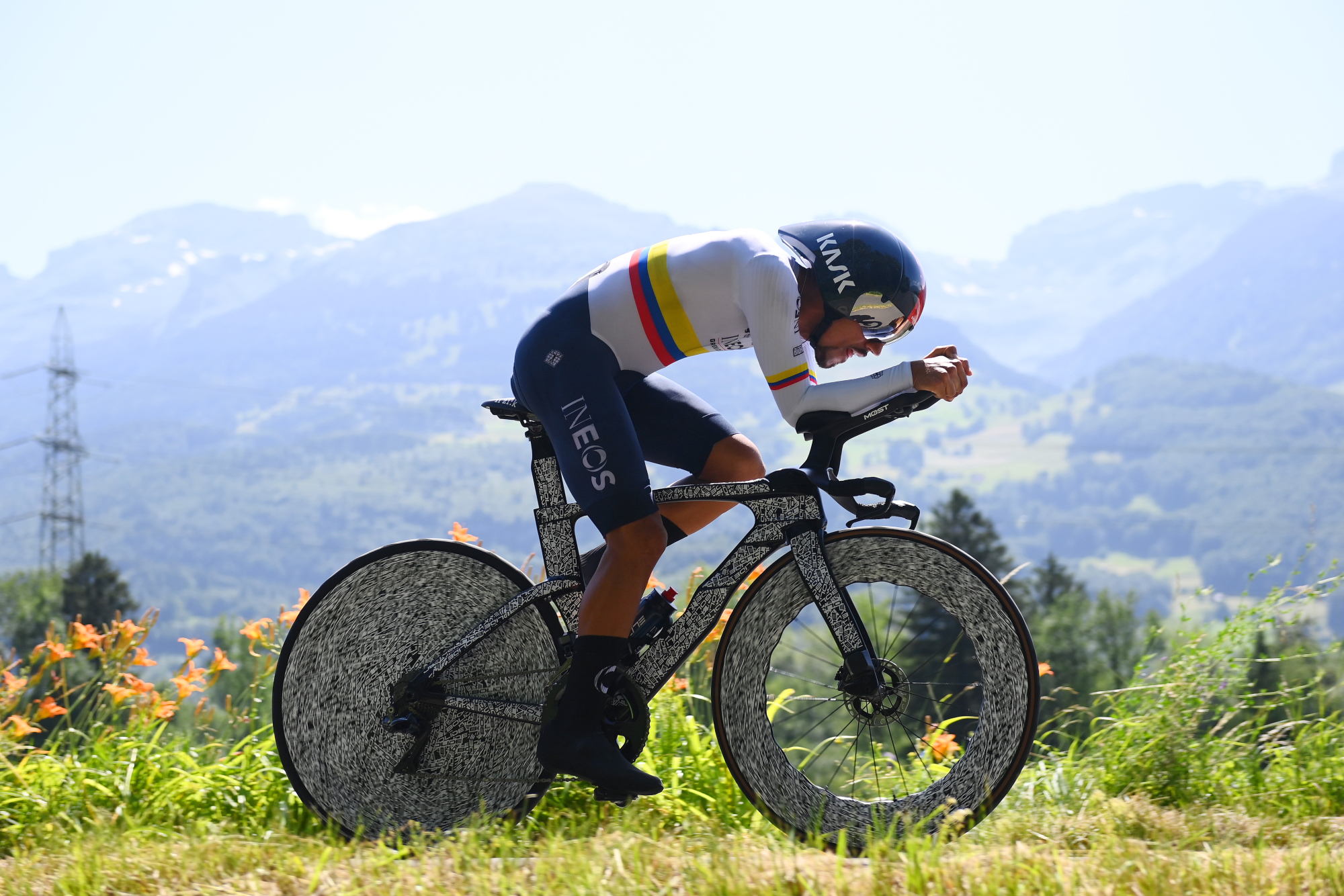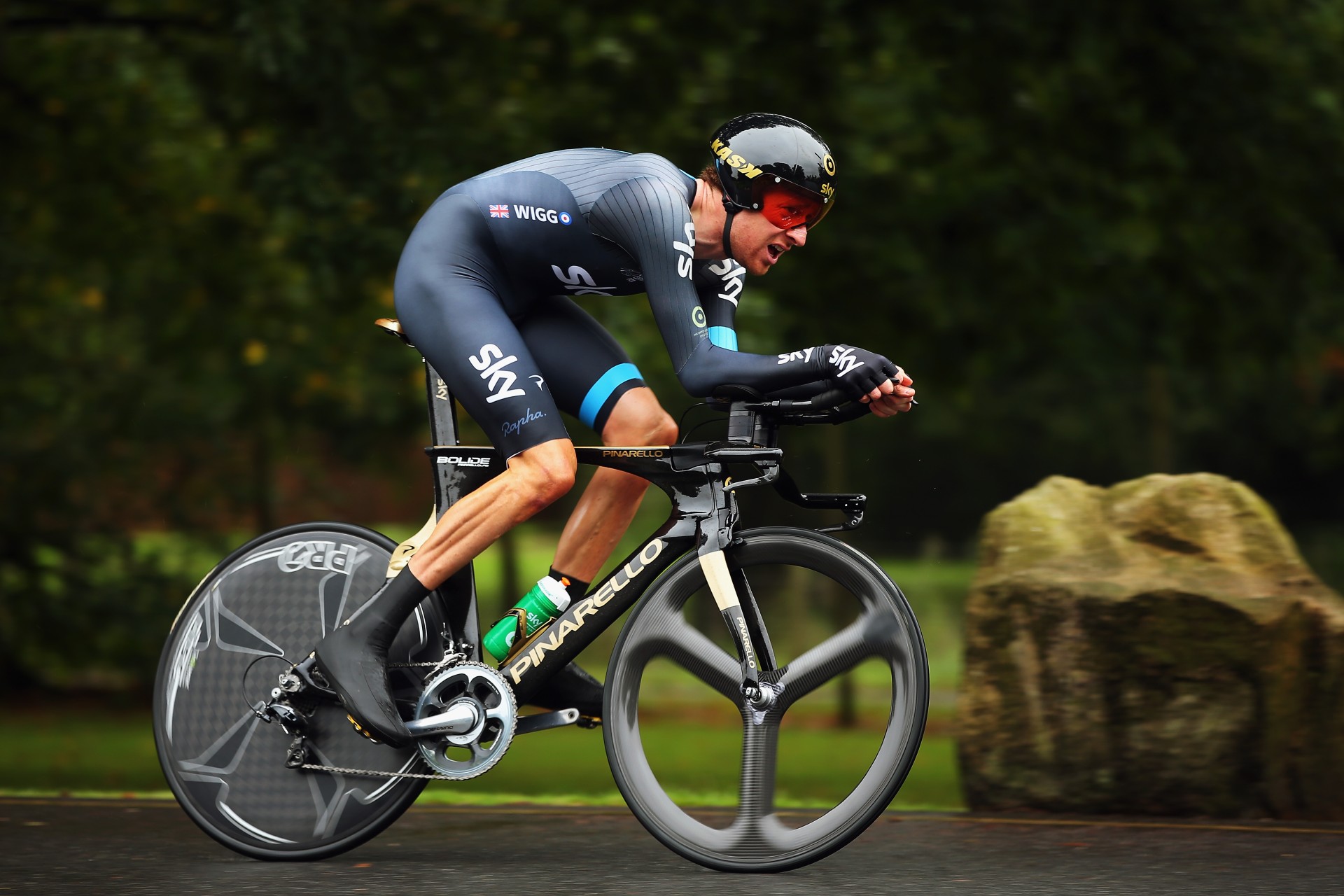New Pinarello Bolide TT bike to help Geraint Thomas chase a second Tour de France win
Geraint Thomas pilots the bike to success in the Tour de Suisse, with design changes ranging from disc brakes to new tubing profiles

Geraint Thomas’ performance at the Tour de Suisse time trial was impressive. Second place on the day behind winner Remco Evenepoel, it secured the Welshman the overall title just two weeks out from the start of the Tour de France.
But almost as eye-catching was the redesigned Pinarello Bolide TT bike he was aboard. Also ridden by fellow Ineos Grenadier Dani Martinez, the new Bolide was decked out in a black and white paint job made up of repeated ‘Bolide’ type, giving the impression that the bike was covered in wrapping paper.
"It’s obviously a new bike and they’re trying to keep it under wraps until the Tour,” Thomas said after the stage. However, there was no disguising some of the significant changes from the previous model.
Unsurprisingly the new-look Bolide has made the switch to disc brakes. The original bike was released in 2013 and has received only minor changes since then, so an update to the braking was always likely to be a focal point of its redesign.
In real time, the move away from rim brakes looks like the main difference between the Bolide old and new. Changes in frame design can be hard to spot at 55kph. But after examining a few still images there’s plenty that’s new.

The Bolide’s new silhouette is still quintessentially Pinarello. The smooth curves that help distinguish all its bikes, including the Dogma F that Ineos race during road stages, remain. But those tube shapes are noticeably different from the previous models. The first iteration featured a pan flat top tube, the second version had it more arched whereas the new model features a slight curvature, not unlike the previously mentioned Dogma F.

Bradley Wiggins rides the original Bolide in the Tour of Britain in 2013
Follow that top tube in either direction and you’ll soon get to the Bolide’s more significant changes. The seat tube has a completely new look. Gone is the Batmobile-esque ‘guard’ that used to cover the rear rim brake - controversial at the time since it was clearly a fairing. That's been replaced by a far simpler profile that intersects with the top tube in a straightforward fashion.
The seat tube still features a rear wheel cutaway, and this section appears a little deeper than before. As for the seatstays, the removal of the rim brake cover ensures they’re more prominent. Again, they appear in the images to be deeper.
At the front end of the bike, the changes are just as pronounced. The head tube is, you guessed it, deeper than before. It’s a move we’ve seen plenty of recently, most notably in both the new Trek Madone that surfaced at the Critérium du Dauphiné, and the re-designed Cervelo S5 that Jumbo–Visima have been using to great effect this season. The aerodynamic benefits of this deeper head tube profile appear to have been accepted across the board so expect more brands to follow suit over the coming months. The new Bolide head tube is also of course sans rim brake cover, with the new design presumably adopting the aero frontal profile of the earlier cover.
The forks continue in the same vein, with the blades far deeper than the old Bolide's. This increased depth also means they are less curved than before but presumably more aerodynamic. Likewise, the down tube has a new profile, featuring an obviously deeper front wheel cutaway as well as a change in its width: narrower in the top section, wider in the lower area, where the bottle cage is mounted.
Elsewhere, both Thomas and Martinez were using their existing base bar and extensions, made by Pinarello's house brand Most. They also appear to have used two different seat post profiles, with Thomas’ seeming to have more setback than his teammate. It’s hard to see the bike’s bottom bracket area from the photos available but it would make sense that it adopted the tall BB of the previous Bolide.
So a new time trial bike with deeper, more aero tubing and disc brakes? It’s fair to say that even if Pinarello had chosen to cover it in bubble wrap until the opening time trial in Copenhagen on July 1 we’d have still been able to hazard a guess at the changes. That said, given Thomas's and Martinez’s performance this weekend (Martinez finished the stage in fourth place, just 28 seconds behind Evenepoel) they would appear to be ones well worth making.

Thank you for reading 20 articles this month* Join now for unlimited access
Enjoy your first month for just £1 / $1 / €1
*Read 5 free articles per month without a subscription

Join now for unlimited access
Try first month for just £1 / $1 / €1
Get The Leadout Newsletter
The latest race content, interviews, features, reviews and expert buying guides, direct to your inbox!
Luke Friend has worked as a writer, editor and copywriter for twenty five years. Across books, magazines and websites, he's covered a broad range of topics for a range of clients including Major League Baseball, the National Trust and the NHS. He has an MA in Professional Writing from Falmouth University and is a qualified bicycle mechanic. He has been a cycling enthusiast from an early age, partly due to watching the Tour de France on TV. He's a keen follower of bike racing to this day as well as a regular road and gravel rider.
-
 'It took everything' - Puck Pieterse outclimbs Demi Vollering to win La Flèche Wallonne
'It took everything' - Puck Pieterse outclimbs Demi Vollering to win La Flèche WallonneDutch 22-year-old shows Classics pedigree with first one-day victory
By Tom Davidson
-
 Tadej Pogačar flies to dominant victory at La Flèche Wallonne
Tadej Pogačar flies to dominant victory at La Flèche WallonneSlovenian takes second win at Belgian classic ahead of Kévin Vauquelin and Tom Pidcock
By Tom Thewlis